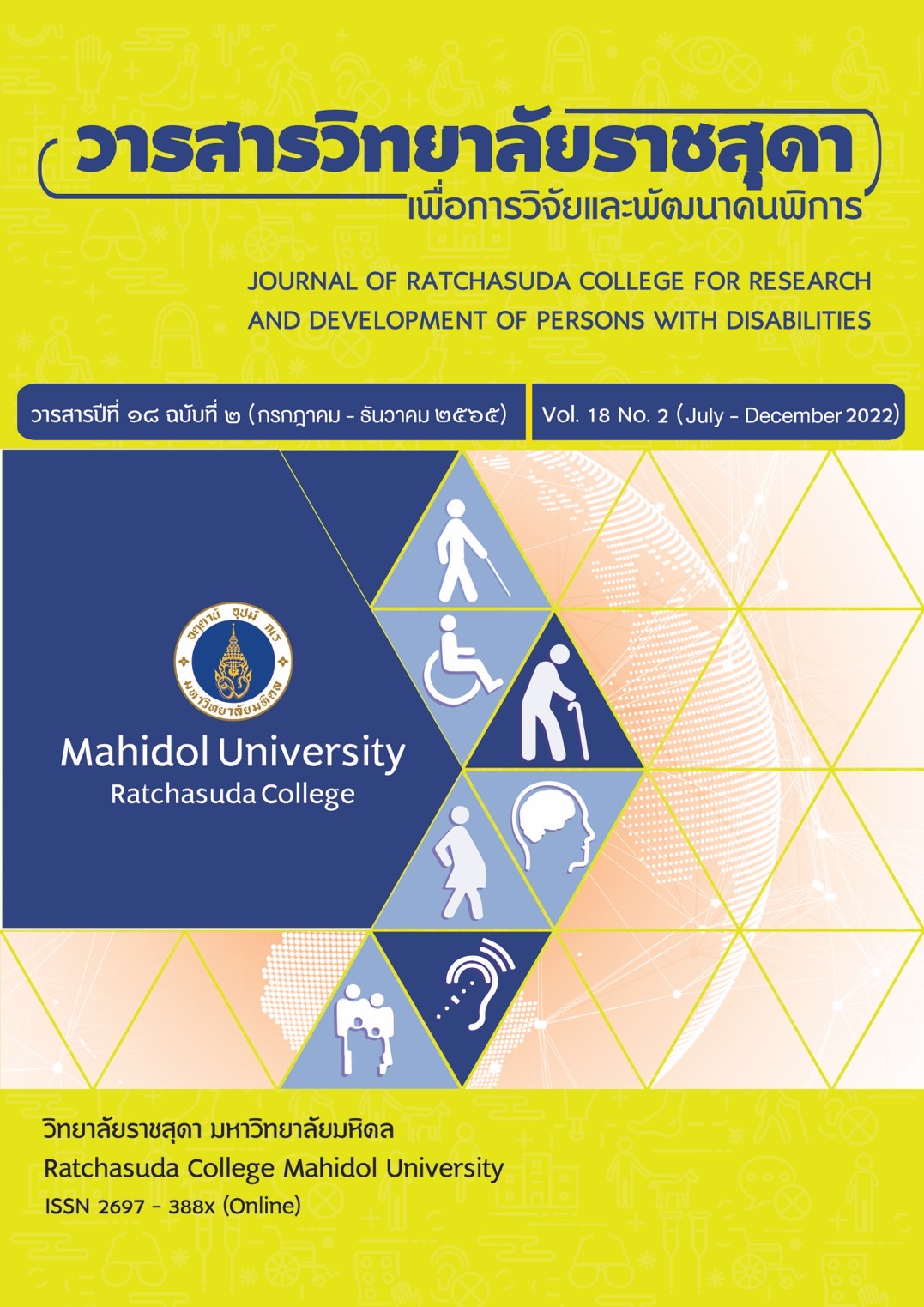Usage of the functional activity package to improve basic line writing ability of a child with multiple disabilities in primary 2
Keywords:
The Functional Activity Package, Basic Line Writing Ability, Multiple DisabilitiesAbstract
The objectives were: 1) To study the abilities to use arms and hands of student with multiple disabilities in primary school, before and after using the functional activity package. 2) To study the abilities to write 13 basic lines of student with multiple disabilities in primary school, before and after using the functional activity package. 3) To compare the ability scores to write the basic line, before and after using the functional activity package. The case study of one male, selected by purposive sampling, age of 8, with multiple disabilities: autism and hearing impairment (hard of hearing), studying in grade 2 at special education school for children with disabilities. The instruments that were used in this research included 1) An assessment form for wrote abilities of 13 basic line 2) An observation form on the behavior of used arms and hands. 3) The functional activity package: 3 Individual Implementation Plans (IIP) that consists of a planting activity, a watering plant activity and an activity to make a Thai dessert called Bualoy. The researcher used the functional activity package as the base of 3 activities per week, 18 sessions over a period of 6 weeks. The data were analyzed by using mean, percentage, standard deviation and descriptive analysis. The results showed that the mean score of arms and hands used behaviors while using the functional activity package was 3.09 which was considered good. The ability scores to write the 13 basic lines after using the functional activity package was 32 points which was considered good. The difference in scores on the ability to write 13 basic lines from before to after using the functional activity package was 16 points or 30.77 %. The video that were recorded to observe the behaviors for 6 weeks found a change in the use of arms and hands from the 4th time onwards, he showed a good core stability and fixation of the shoulder joint at work free movement of the forearm, and was able to touch objects without avoidance or a disgusting expression. Moreover, the case study showed abilities to move both arms across the body midline, and to switch objects between hands automatically, as well as improved hand functions and in-hand manipulation skills.
Downloads
References
Announcement of the ministry of education on the determination of categories and criteria for educational disabilities Act B.E. 2009. (2009). Government Gazette. 126(80), 46-47.
Bruni, M. (2006). Fine motor skill in children with down syndrome: A guide for parents and professional. Bethesda Maryland: Woodbine House.
Gesell, A. (1940). The first five years of life: A guide to study of the preschool child. New York: Harper.
Horadal, A., Phonyothin, P., Tancharoen, R., Maksaman, W., Meesomsan, K., Chatisathien, C., & Soontrapirom, S. (2018). Organizing physical, emotional, mental and social experiences for early childhood, unit 1-7. Sukhothai: Sukhothai Thammathirat University.
Korsuwan, K. (2010). Teaching children with mild disabilities. Bangkok: Sahamit Printing and Publishing Company Limited.
Kushki, A., Chau, T., & Anagnostou, E. (2011). Handwriting difficulties in children with autism spectrum disorders. Journal of autism and developmental disorders. 2(41), 1706-1716.
Lesilp, T. (2015). Educational management for children with hearing impairment. Chiang Mai: Chiang Mai Rajabhat University.
Mesibov, B. G., Shea, V., & Schopler, E. (2004). The TEACCH approach to autism spectrum disorders. New York, United States: Springer Science and Business Media.
McMillan, I. R. (2011). The biomechanical frame of reference in occupational therapy. In E. A. S. Duncan (Ed.), Foundations for practice in occupational therapy (5th ed., pp. 179-194). Edinburgh: Churchill Livingstone.
Ministry of Education. (2002). National education act, B.E. 2542 and amendments (No. 2), B.E. 2002. Bangkok: Ministry of Education.
Ministry of Education. (2008). Education management for persons with disabilities Act 2008. Bangkok: Ministry of Education.
National Institute on Deafness and Other Communication Disorders. (2012). Communication Problems in children with autism spectrum disorder. Turning Discovery into Health, 97-4315.
Piaget, J. (1952). The Original of intelligence in children. New York: International Universities Press.
Ratzon, N. Z., Efraim, D., & Bart, O. (2007). A short-term graphomotor program for improving writing readiness skills of first-grade student. American Journal of Occupational Therapy, 61, 399-405.
Special Education Bureau. (2019). Education management for people with multiple disabilities [E-book]. Bangkok: Special Education Bureau. Retrieved from https://pubhtml5.com/rqbh/zlmy/basic.
Tantipalachiwa, K. (2008). Organization of learning activities for early childhood. Bangkok: Brain-Base.
Thorndike, E. L. (1923). Education a first book. New York: Macmillan Company.
Downloads
Published
How to Cite
Issue
Section
License
Copyright (c) 2022 JOURNAL OF RATCHASUDA COLLEGE FOR RESEARCH AND DEVELOPMENT OF PERSONS WITH DISABILITIESบทความที่ได้รับการตีพิมพ์เป็นลิขสิทธิ์ของวารสารสถาบันราชสุดาเพื่อการวิจัยและพัฒนาคนพิการ






